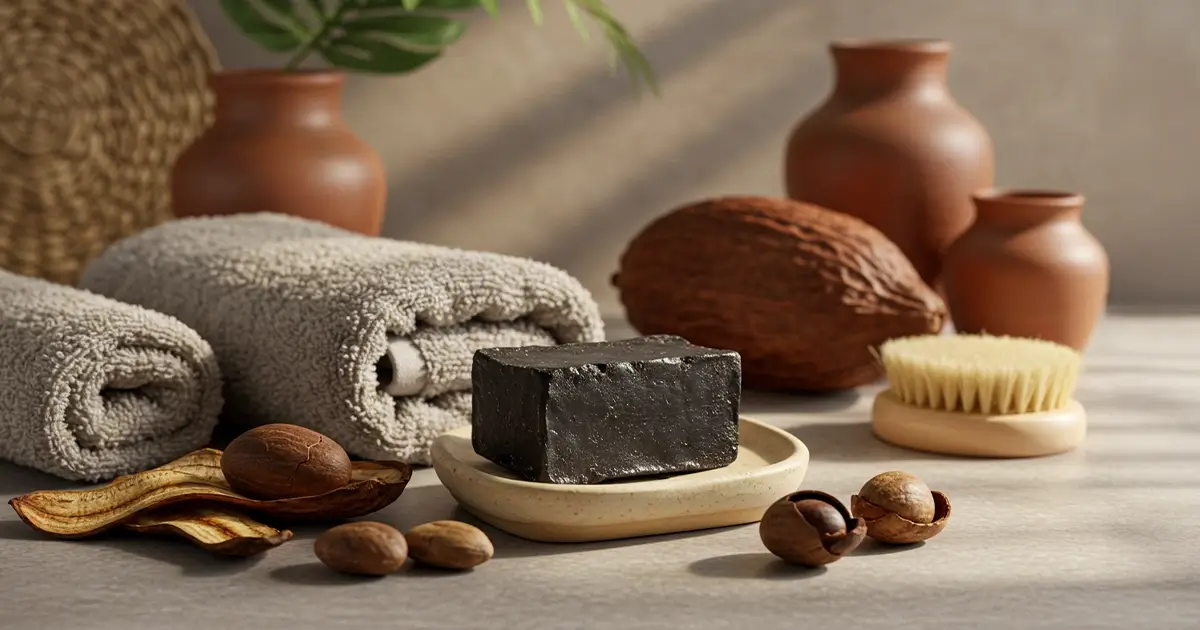Today we're taking a soapy safari into the world of African black soap, the legendary bar that cleanses, calms, and somehow never leaves skin feeling like the Sahara. You'll learn where it comes from, why its gentle cleansing powers feel practically poetic, and exactly how to weave this earthy superstar into a balanced skincare routine.
The Story in the Suds: Origins and Craftsmanship
Before black soap became a bathroom MVP, it was a communal craft rooted in Ghana, Nigeria, and neighboring regions. Women in these communities still roast plantain skins, cocoa pod husks, and shea tree bark in clay ovens. That ash is mixed with water, unrefined shea butter, and local oils, then cured for weeks - no fancy lab coats required, just generations of know-how and patient hands.
Each batch is as individual as a fingerprint because climate, soil, and even the length of the rainy season change the mineral content of the raw materials. Think of it like wine: terroir affects aroma and character, except here the bouquet smells faintly smoky and earthy instead of oaky and fruity.
The slow curing process yields a bar that's high in skin-loving glycerin and naturally alkaline. Even with a basic pH, the soap behaves kindly toward the acid mantle thanks to an unusually high level of "super-fats" - butters that remain un-saponified and coat skin in a thin, protective film.
Cocoa Pod Ash, Plantain Skin, and Shea: The Power Trio
- Cocoa pod ash delivers gentle exfoliation plus trace minerals like magnesium and iron.
- Plantain skin brings anti-oxidative polyphenols and a dash of vitamin A.
- Raw shea butter supplies stearic and oleic acids that soften without clogging pores.
Why It Cleanses Without Stripping
Modern cleansers often rely on synthetic detergents that lift every last molecule of oil. African black soap takes the opposite approach: it removes surface dirt yet leaves behind enough lipids to keep transepidermal water loss (TEWL) low. In this study, researchers noted a significant reduction in acne lesions after four weeks of daily use, with participants reporting minimal dryness.
The ash works as a mild physical exfoliant, loosening dead cells so they rinse away effortlessly. Meanwhile, naturally occurring saponins - plant-derived surfactants - captivate oil and grime. Because the soap is super-fatted, there's always a buffer of butters ready to fill micro-gaps in the stratum corneum.
Another perk: unrefined shea butter contains triterpenes with documented anti-inflammatory properties. That means calmer redness for reactive faces, even when breakouts decide to throw a party at three a.m. (Honestly, acne has worse timing than my uncle telling dad jokes at weddings.)
pH Perspective
Black soap's pH runs between 8 and 9.5, but the super-fat cushion prevents the usual alkaline sting. If you're coming from a low-pH gel cleanser, think of black soap as a hearty bowl of oatmeal after weeks of salad: richer, warmer, and surprisingly comforting.
Mastering the Ritual: Practical How-To Steps
You've bought an authentic chunk - now what? First, slice a thumb-sized piece and keep the rest airtight. Exposure to moisture can turn the bar mushy faster than a rom-com finale.
- Create a creamy paste. Wet palms, then rub the soap until it forms light cocoa-colored foam. Avoid direct contact between bar and face to cut friction.
- Massage for 30 seconds. Use circular strokes along jawline and T-zone. If you hit 60 seconds you're just giving yourself a mini facial - carry on.
- Rinse with lukewarm water. Hot water strips, cold water shocks; lukewarm keeps Goldilocks happy.
- Pat dry, don't rub. A towel swipe can undo that cushy lipid layer you just worked for.
- Follow with hydrators. A humectant toner plus a ceramide cream will lock in moisture.
Frequency is key. Start every other night if you have combination or sensitive skin. For oily complexions, daily use is usually comfortable after a one-week patch-test period.
Building a Balanced Routine Around Black Soap
Because black soap already supplies gentle exfoliation, pair it with hydrating steps rather than a line-up of extra acids. I like a mist of panthenol toner, a niacinamide serum, and a mid-weight moisturizer - simple yet satisfying, like good toast with better butter.
If you're curious about other storied ingredients from the continent, check out this deep dive into Moroccan argan oil. It's the perfect companion oil for sealing in hydration post-wash.
Morning routines stay the same: cleanse with a gentler gel or micellar water, moisturize, then apply broad-spectrum sunscreen. Reserve black soap for evenings so your skin has all night to bask in its earthy goodness.
Pairing Don'ts
- Skip leave-on AHAs the same night to prevent over-exfoliation.
- Use benzoyl peroxide sparingly; it can cancel out black soap's soothing vibe.
- Retinoids are fine, but let skin dry fully before application to reduce potential irritation.
Myth Busting: Setting the Record Straight
Myth 1: "Black soap bleaches skin." Absolutely not. The color comes from roasted plant materials, not hydroquinone or other lightening agents. What you'll notice is a gradual evening of tone thanks to mild exfoliation, not ghostly pallor.
Myth 2: "All black soaps are created equal." Counterfeits often replace shea butter with cheap animal fats and toss in artificial dyes for extra drama. Authentic bars feel lightly gritty, smell smoky-sweet, and soften when warmed between fingers.
FAQ
Can I use African black soap on dry, eczema-prone skin?
Yes, but limit application to two or three nights per week and always finish with a barrier-repair cream rich in ceramides and cholesterol.
Does black soap remove makeup effectively?
It can melt down sunscreen and light foundation, but waterproof mascara may need an oil pre-cleanse first. Think of black soap as your second-act cleanser in a double-cleanse routine.
Why does my bar develop a white film?
That's shea butter crystallizing on the surface - totally harmless. Scrape it off or lather as usual.
Is the pH too high for sensitive skin?
While its pH is alkaline, the high super-fat content buffers potential irritation. If in doubt, patch test on the inner arm for a few days.
How do I store it to keep it from melting?
Pop the unused portion in a silicone bag or wrap it in wax paper, then place it in a cool, dry drawer - no spa-style shower shelf selfies, please.
Conclusion
African black soap earns its reputation by marrying deep cleansing with tangible softness, courtesy of shea butter and plantain ash. When used thoughtfully - think small slices, lukewarm water, and diligent moisturization - it clarifies without the notorious post-wash tightness.
Got personal tips, DIY hacks, or a hilarious "I dropped the bar on my foot" story? Share them below. See you in the next post - until then, take good care of your skin!


Comments (0)
No comments yet - be the first to share your thoughts!
Leave a Reply
Your email address will not be published. Required fields are marked *